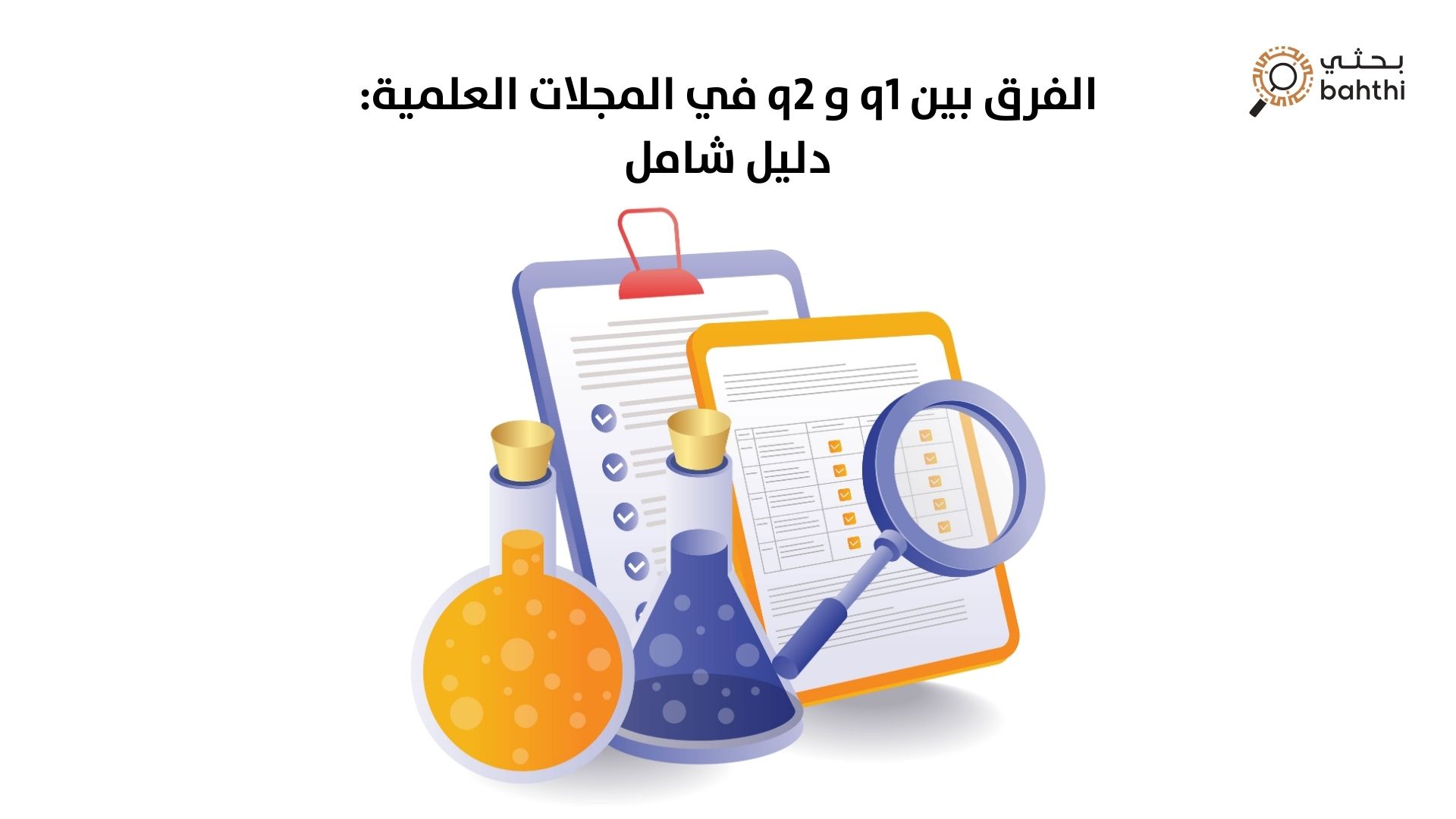

The Difference Between Q1 and Q2 in Scientific Journals: A Comprehensive Guide
In the world of scientific research, publishing papers in peer-reviewed and highly ranked journals is a goal that researchers strive for through platforms like Bahthi, to enhance their academic standing and contribute to the advancement of knowledge. Among the systems used to evaluate the quality of scientific journals, the Quartiles classification system, denoted as Q1, Q2, Q3, and Q4, stands out. This article focuses on explaining the difference between Q1 and Q2, the importance of each in scientific publishing, and their role in providing research services.
The Concept of Quartile Classifications
Quartile classifications are used to evaluate scientific journals based on their impact and importance in their respective fields. Journals are divided into four quartiles based on a set of indicators, the most prominent of which is the Impact Factor. This system gives researchers an idea of the journal's standing within its academic field, helping them choose the right journals to publish their work. The difference between Q1 and Q2 can be explained as follows: journals ranked Q1 are considered to have the highest impact within their field, while Q2 journals rank next in terms of influence and academic significance.
Definitions of the Difference Between Q1 and Q2
Q1 Classification:
Q1 includes journals that fall within the top 25% of journals in their field. These journals are highly influential and well-regarded in the academic community, known for their strict publishing standards and high-quality research. Papers published in Q1 journals are widely recognized, increasing the chances for the researcher to gain greater academic and professional recognition.
Q2 Classification:
Q2 includes journals ranked between 25% and 50%, meaning they fall within the second quartile. These journals maintain good quality and contribute significantly to the dissemination of knowledge, but they have a lower impact than Q1 journals. Publishing in Q2 journals is an excellent option for researchers who want to enhance their academic record without facing the strict acceptance standards of Q1 journals.
Classification Criteria
The classification of journals within the different quartiles is based on several criteria, including:
- Impact Factor: Measured by the number of citations received by the journal’s articles over a set period. The higher the Impact Factor, the higher the journal’s standing in the classification.
- Citations: Indicates how frequently other researchers cite the articles published in the journal, reflecting the quality and importance of the content.
- Reputation of the Journal: Dependent on how the academic community evaluates the journal and its reliability, with universities and scientific institutions favoring reputable journals.
- Acceptance Rate of Papers: Journals with strict acceptance criteria often rank higher in classification, as submitted papers undergo a rigorous peer-review process before publication.
The Difference Between Q1 and Q2
The difference between Q1 and Q2 lies in the level of impact and reputation:
- Impact and Reach: Q1 journals have a greater impact and wider reach compared to Q2 journals, with a higher number of citations.
- Publishing Standards: The publishing standards in Q1 journals are stricter, making the acceptance process more competitive and challenging.
- Citations: Research published in Q1 journals generally receives more citations, increasing its influence in the scientific community, whereas Q2 journals have relatively fewer citations.
- Ease of Acceptance: Q2 journals are generally more flexible in accepting research, as they do not demand the same level of innovation or originality required by Q1 journals.
The Importance of Publishing in Q1 and Q2 Journals
Publishing in top-tier journals, particularly the difference between Q1 and Q2, is a necessary step for researchers aiming to achieve widespread scientific impact and advance their academic and professional careers. Publishing in these journals enhances the researcher’s position within the academic community, increases the potential for international research collaboration, and serves as an indicator of the quality of the research submitted.
Publishing in Q1 Journals:
Publishing in Q1 journals is a golden opportunity for researchers, as these journals represent the highest levels of quality and academic impact. The research submitted undergoes a stringent peer-review process by experts in the field, ensuring that only papers with high scientific value are accepted. Publishing in Q1 journals provides researchers with a prestigious academic reputation, increases their chances of obtaining research grants and academic promotions, and contributes to improving their chances of securing prestigious academic positions.
Publishing in Q2 Journals:
Q2 journals, while less impactful than Q1 journals, are still an ideal choice for researchers who wish to publish their work quickly while maintaining a good level of scientific quality. These journals have a thorough and systematic review process but are generally more flexible compared to Q1 journals, which helps researchers publish their work within a reasonable timeframe. They also contribute to expanding the researcher’s academic reach and broadening their research influence in their field.
The Role of Research Services in Supporting Academic Publishing
Research services play a key role in helping researchers choose the right journals and improving the quality of their research to meet the publishing standards of Q1 and Q2 journals. The difference between Q1 and Q2 lies in their level of impact and academic importance. These services also provide support in various stages, such as proofreading, statistical data analysis, and improving the structure of the research, increasing the chances of acceptance in leading scientific journals.
How to Choose the Right Journal for Publishing
When selecting the appropriate journal for publishing their research, researchers should consider several factors to ensure their research reaches the targeted audience and achieves maximum scientific impact. These factors include:
- Clearly Defining Research Objectives: If the research aims to achieve broad exposure and significant impact in its field, it’s preferable to choose a Q1 journal. If the goal is to publish the research quickly, publishing in a Q2 journal may be a suitable option.
- Reviewing the Journal’s Requirements: It’s essential to carefully read the journal’s submission guidelines and ensure the research aligns with the publication and formatting requirements. Researchers should also review previously published studies in the journal to understand the type of studies accepted.
- Analyzing Impact Factor: The Impact Factor is an indicator of how widely the research published in the journal is spread. Choosing a journal with a high Impact Factor ensures the research reaches a broad audience of academics and researchers.
- Reviewing Publication Time: Some journals take a long time in the peer-review process, sometimes months or even years before accepting a paper. It’s advisable to choose a journal that fits the researcher’s timeline and academic and professional plans.
- Checking Journal’s Ranking in Global Databases: Researchers should ensure the journal is listed in reputable scientific databases such as Scopus or Web of Science, as this guarantees international recognition for the research.
- Publication Fees: Some journals charge publication fees, so researchers should ensure the publication costs fit within their research budget, avoiding the trap of predatory or non-peer-reviewed journals.
The difference between Q1 and Q2 in scientific journals is crucial for researchers when choosing the right journal for publishing their work. Publishing in Q1 journals offers a higher level of impact and reputation, while publishing in Q2 journals provides a more flexible and less competitive option. Research services provide the necessary support to help researchers select the right journal and meet the required academic publishing standards. By understanding these differences, researchers can make more informed decisions that will enhance their academic career.


